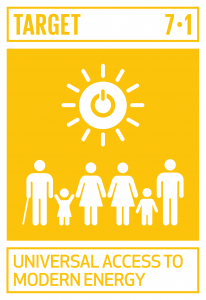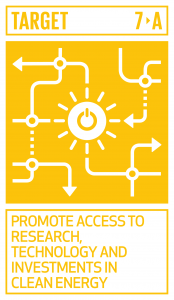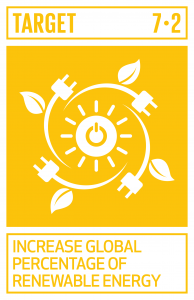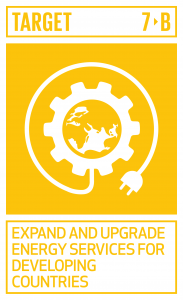SDG 7 focuses on affordable, reliable and sustainable access to modern energy services. This includes ensuring universal access to energy services (SDG 7.1), increasing the proportion of renewable energy sources used to supply these services (SDG 7.2) and doubling the rate of energy efficiency improvements globally (SDG 7.3).1
Access to energy is crucial for achieving almost all of the Sustainable Development Goals, from the eradication of poverty through advancements in health, education, water supply and industrialization to combating climate change.2
Energy has been described as core to achieving the 2030 Agenda. Despite this, based on current trends there will still be 2.3 billion people globally who will not have access to clean efficient cooking technologies that protect their environment and health. This problem must be urgently addresses to meet the targets of SDG 7 and the other SDGs, particularly those linked to mitigating climate change (such as SDG 13).
The proposed global approach is to use public funding to strongly encourage investment in renewable energy and energy efficient technologies. In particular, local capacity building to support private sector investment in decentralised energy infrastructure is seen as a key approach to enabling equitable access to energy. The High-Level Political Forum review of SDG 7 has emphasised the importance of regional cooperation to this end.3
Transition from the MDG targets to SDG 7 in Cambodia
The earlier Millenium Development Goals (MDGs) did not have a specific focus on equitable access to energy. Target 7.A referred broadly to introducing sustainable development principles into national policies and reversing losses of environmental resources. Target 7.B focused on reducing biodiversity losses, partially through an indicator to reduce CO2 emissions.4 When this was localised in the Cambodian MDGs, it was adapted to target a reduction of the percentage of households dependent on fuel wood to 52% by 2015.5
This was the only energy indicator for the MDGs and in the 2015 Cambodia Socio-Economic Survey (CSES), it was shown that 82% of Cambodians were still reliant on either firewood (73.9%) or charcoal (8.1%) as the primary source of cooking fuel.6 The 2016 National Biodiversity Strategy and Action Plan, which is aligned with the SDGs, notes that fuel wood accounts for approximately 70% of the total national energy demand and is a driver of heavy forest logging, resulting in both indoor and outdoor air pollution as well as other environmental problems.7
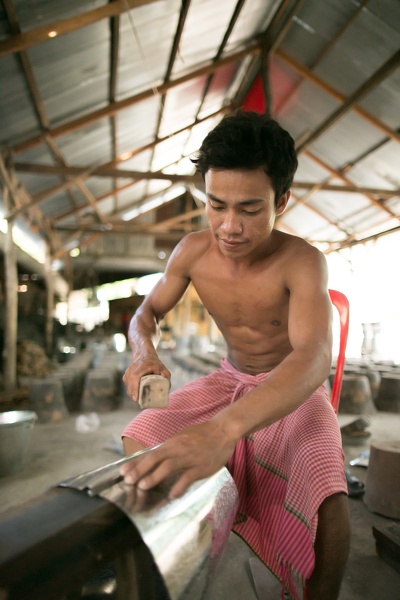
Man producing an improved cookstove in Cambodia. Photo by Sheepad, taken on 17 December 2013. License under CC BY-SA 3.0
When the localised SDG indicators are released later in 2018 it is likely that Cambodia will use indicators focused more on active strategies to produce results. SDG 7 global indicators include:
- Increasing the proportion of people with access to electricity (Indicator 7.1.1) with more people relying on clean fuels and technologies (Indicator 7.1.2)
- Increasing the share of renewable energy sources used (Indicator 7.2.1)
- Reducing the intensity of energy use in general, as well as in terms of GDP (Indicator 7.3.1).
Access to electricity in Cambodia has been increasing steadily since the 1990s.8 However, in 2009, when access to electricity stood at 34.4% for the country, grid equivalent electrification rates were only at about 15% and mainly confined to urban households (55%) compared to rural households (5%).9
A need for greater emphasis on sustainable, renewable energy in the overall national energy mix has also been identified.10 While some households in Cambodia are able to connect to a reliable, centralised electricity supply, this is not the case in all areas of the country. While biofuels, natural gas and other fuels are used for cooking and other household activities, these sources are often not able to sustainably provide a stable energy supply.
To address growing demand, conventional electricity production has been adopted, mostly through large-scale hydropower and coal-fired electricity plants.11 The development of coal-fired generation has had the effect of fairly significantly reducing the percentage of energy consumption being accessed from renewable sources.
Localization of SDG 7 in Cambodia
The Ministry of Mines and Energy (MOME) is primarily responsible for implementing SDG 7 in Cambodia. In 2016, a rapid integrated assessment found that SDG 7 was already aligned with Cambodia’s national policies.12 These include the National Strategic Development Plan (2014–2018), which continues the implementation of the the Energy Sector Development Plan (2005–2024), as well as the Rural Electrification Master Plan (REMP) 2003 and the Renewable Energy Action Plan (REAP) 2003.13
For example:
- For SDG target 7.1, the Royal Government of Cambodia (RGC) is likely to continue with its ambitious targets to provide access to any type of electricity (including battery power) to 100% of villages by 2020, increasing from 62% of villages in 201514 and to grid-quality electricity for 70% of households by 2030.15
- While Cambodia has not yet set a localized version of SDG target 7.2, the WWF has outlined a potential ‘Sustainable Energy Scenario’ for the country. This demonstrates that it is technically feasible to supply everyone with 100% of the energy they need with 90% coming from renewable sources. Analyses such as these may influence the target that the RGC sets for 2030.16
- Again, while no localised target has been set for SDG target 7.3, Cambodia has significant potential to increase energy efficiency in the country quickly. For example, in 2013, a draft National Policy, Strategy and Action Plan on Energy Efficiency (EU Energy Initiative Partnership Dialogue Facility) developed an overall goal of reducing national energy demand by 20% by 2035 compared to business as usual (BAU), with a general reduction target of 10% in each sector by 2030.17
Means of implementation for SDG 7 in Cambodia
There are two ‘means of development’ indicators for SDG7 that will support Cambodia as a least developed country to access the resources and technology that the country requires to meet the targets. They involve:
- Enhanced international cooperation on clean energy research and technological development, especially in the areas of renewable energy, and promoting investment in energy infrastructure and clean energy technology (SDG 7.A)
- Greater investment in infrastructure and technology to supply modern, sustainable energy services for developing countries such as Cambodia (SDG 7.B).
Currently, much of the electrification programme in Cambodia is large-scale and centrally coordinated and planned by the state-owned enterprise Electricité du Cambodge (EDC) at a cost that is not affordable in all areas of Cambodia. To achieve the SDG7 targets, it will be important to attract investment in infrastructure and appropriate technology for rural electricity enterprises such as sub-transmission networks, isolated mini-grids and off-grid systems. 18
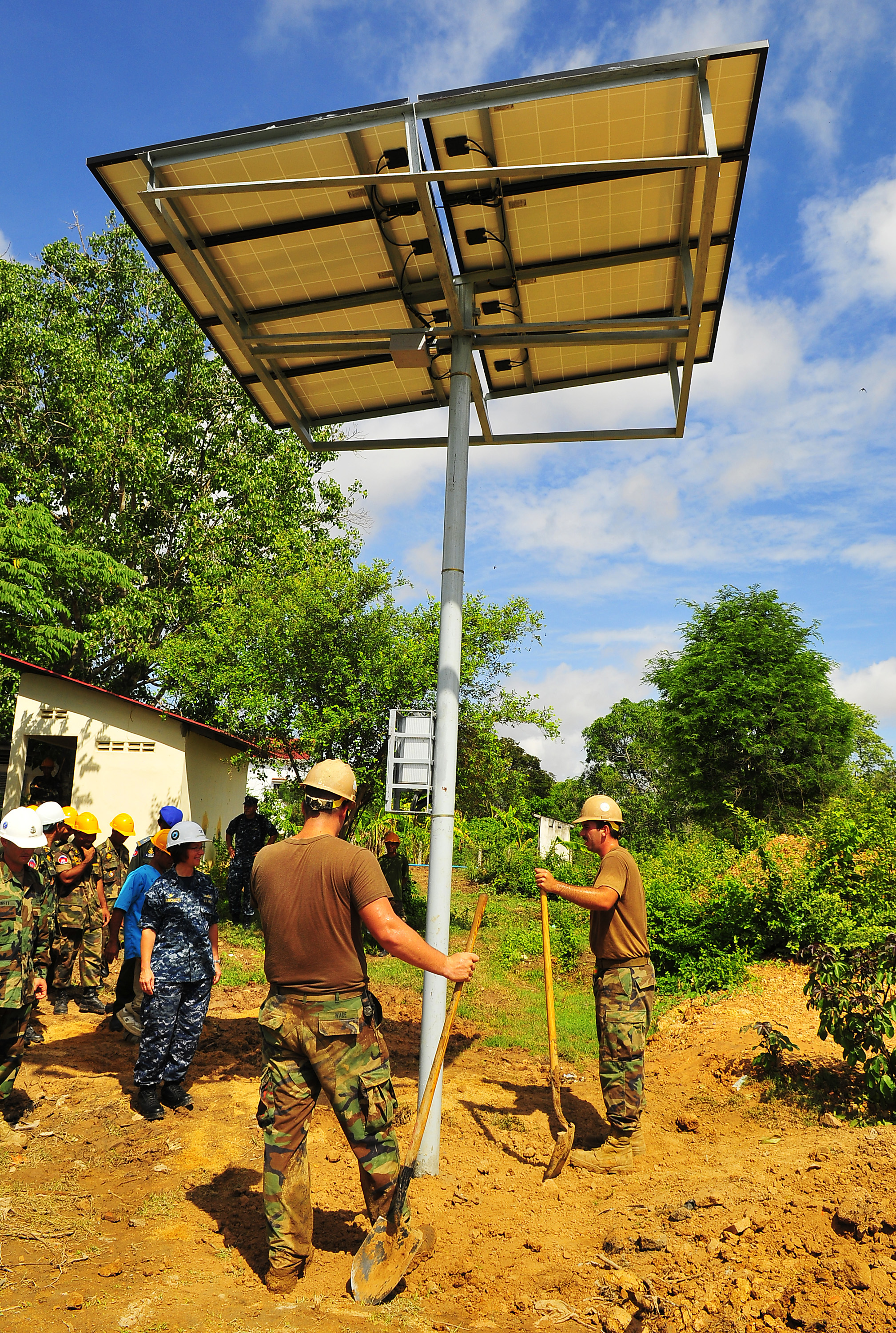
A regional partnership installing an off-grid solar energy system at Chambok, Kampong Speu Province, Cambodia. Photo by U.S. Navy Mass Communication Specialist 2nd Class Jon Husman, taken on 23 June 2010. License under Wikimedia Commons
The risk of these investments will need to managed with a range of financing mechanisms that encourage private sector investment, while still developing the capacity of the EDC to access all citizens in Cambodia. This will involve a scale of investment that meets rural electrification targets of approximately 100,000 rural households annually by 2030, or 2.1 million rural households in total during the implementation of the SDGs.19
Investments into technological development of options such as solar and small-scale and micro-hydro energy generation will likely need to be leveraged by increased levels of public funding and cooperation with international mechanisms such as the ASEAN Centre for Energy, the International Energy Agency (IEA), and the UN Green Climate Fund.20
Monitoring SDG 7 in Cambodia
The major focus of the the SDG targets in Cambodia is the expansion of rural electrification plans and the accessibility of the electricity grid. This will form the core of the monitoring and evaluation process for SDG 7 in Cambodia.21
Over the period to 2030, timely collection and analysis of data will be useful for enabling smart investments to be made to promote investments that transform how rural people access energy. Progress must increase the equitability of how energy is both produced and distributed. In particular, the data collected for SDG 7 will be vital for developing more integrated targets to better assess the impacts of policies promoting large scale hydropower such as the upstream and downstream social impacts.22
Related topics
- Sustainable Development Goals
- Hydropower dams
- Energy policy and administration
- Renewable energy production
- Cooking fuel
References
- 1. United Nations Development Programme (UNDP). “Enhancing capacity development for SDG7”. Accessed September 2018.
- 2. Sustainable Development Knowledge Platform. “Sustainable Development Goal 7”. Accessed September 2018.
- 3. United Nations. “Accelerating SDG 7 Achievement: Policy briefs in support of the first SDG 7 review at the UN High-Level Political Forum 2018”. Sustainable Development Knowledge Platform. Accessed September 2018.
- 4. UN-NLGS. “MDG Targets and Indicators”. Accessed September 2018.
- 5. Ministry of Planning, 2010. “Achieving Cambodia’s Millennium Development Goals: Update 2010”. Accessed September 2018.
- 6. National Institute of Statistics, 2015. “Cambodia Socio-Economic Survey 2015,” Phnom Penh, October 2016. Accessed September 2018.
- 7. National Council for Sustainable Development (NCSD), 2016. “National Biodiversity Strategy and Action Plan 2016”, February 2016. Accessed September 2018.
- 8. World Bank Open Data. “Access to electricity (% of population)” Accessed September 2018.
- 9. Ministry of Industry Mines and Energy, 2009. “Cambodia – Rural electrification strategy and implementation plan”. Accessed September 2018.
- 10. World Wide Fund for Nature, 2016. “Power Sector Vision: Toward 100% Renewable Energy by 2050 – Greater Mekong Region Cambodia Report” Accessed September 2018.
- 11. Ministry of Mines and Energy and Economic Research Institute for ASEAN and East Asia, 2016 “Cambodia National Energy Statistics 2016“. Accessed September 2018.
- 12. United Nations of Development Programme (UNDP), “Rapid Integrated Assessment – Cambodia SDG Profile,”(United Nation in Cambodia). Accessed September 2018.
- 13. Poch, K. (2013), ‘‘Renewable Energy Development in Cambodia: Status, Prospects and Policies’’, in Kimura, S., H. Phoumin and B. Jacobs (eds.), Energy Market Integration in East Asia: Renewable Energy and its Deployment into the Power System, ERIA Research Project Report 2012-26, Jakarta: ERIA. pp.227-266. Accessed September 2018.
- 14. World Wide Fund for Nature, 2016. “Power Sector Vision: Toward 100% Renewable Energy by 2050 – Greater Mekong Region Cambodia Report.” Accessed September 2018.
- 15. ASEAN Centre for Energy, 2016. “Universal Access to Energy in ASEAN: the Cases of Cambodia and Lao PDR”. Accessed September 2018.
- 16. World Wide Fund for Nature, 2016. “Power Sector Vision: Toward 100% Renewable Energy by 2050 – Greater Mekong Region Cambodia Report” Accessed September 2018.
- 17. Asian Development Bank, July 2015. “Energy Efficiency Development and Potential Energy Savings in the Greater Mekong Sub-region”. Accessed September 2018.
- 18. World Bank, 2009. “Cambodia – Rural electrification strategy and implementation plan”. Accessed September 2018.
- 19. Ibid,
- 20. Ministry of Mines and Energy and Economic Research Institute for ASEAN and East Asia. “Cambodia National Energy Statistics 2016“. Accessed September 2018.
- 21. Asian Development Bank. “Energy Efficiency Development and Potential Energy Savings in the Greater Mekong Sub-region”, July 2015. Accessed September 2018.
- 22. United Nations. “Accelerating SDG 7 Achievement: Policy briefs in support of the first SDG 7 review at the UN High-Level Political Forum 2018”. Sustainable Development Knowledge Platform. Accessed September 2018.
